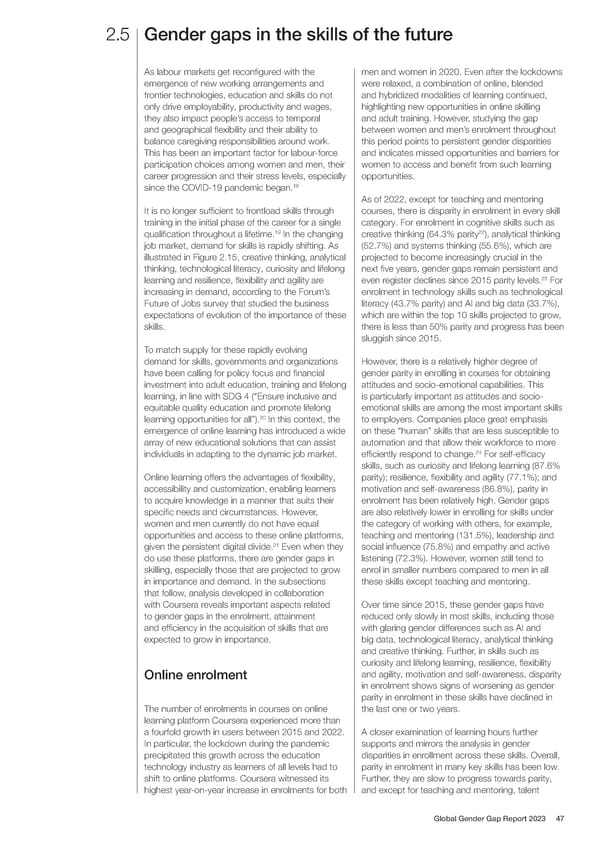2.5 Gender gaps in the skills of the future As labour markets get recon昀椀gured with the men and women in 2020. Even after the lockdowns emergence of new working arrangements and were relaxed, a combination of online, blended frontier technologies, education and skills do not and hybridized modalities of learning continued, only drive employability, productivity and wages, highlighting new opportunities in online skilling they also impact people’s access to temporal and adult training. However, studying the gap and geographical 昀氀exibility and their ability to between women and men’s enrolment throughout balance caregiving responsibilities around work. this period points to persistent gender disparities This has been an important factor for labour-force and indicates missed opportunities and barriers for participation choices among women and men, their women to access and bene昀椀t from such learning career progression and their stress levels, especially opportunities. 18 since the COVID-19 pandemic began. As of 2022, except for teaching and mentoring It is no longer suf昀椀cient to frontload skills through courses, there is disparity in enrolment in every skill training in the initial phase of the career for a single category. For enrolment in cognitive skills such as 19 22 quali昀椀cation throughout a lifetime. In the changing creative thinking (64.3% parity ), analytical thinking job market, demand for skills is rapidly shifting. As (52.7%) and systems thinking (55.6%), which are illustrated in Figure 2.15, creative thinking, analytical projected to become increasingly crucial in the thinking, technological literacy, curiosity and lifelong next 昀椀ve years, gender gaps remain persistent and 23 learning and resilience, 昀氀exibility and agility are even register declines since 2015 parity levels. For increasing in demand, according to the Forum’s enrolment in technology skills such as technological Future of Jobs survey that studied the business literacy (43.7% parity) and AI and big data (33.7%), expectations of evolution of the importance of these which are within the top 10 skills projected to grow, skills. there is less than 50% parity and progress has been sluggish since 2015. To match supply for these rapidly evolving demand for skills, governments and organizations However, there is a relatively higher degree of have been calling for policy focus and 昀椀nancial gender parity in enrolling in courses for obtaining investment into adult education, training and lifelong attitudes and socio-emotional capabilities. This learning, in line with SDG 4 (“Ensure inclusive and is particularly important as attitudes and socio- equitable quality education and promote lifelong emotional skills are among the most important skills 20 learning opportunities for all”). In this context, the to employers. Companies place great emphasis emergence of online learning has introduced a wide on these “human” skills that are less susceptible to array of new educational solutions that can assist automation and that allow their workforce to more 24 individuals in adapting to the dynamic job market. ef昀椀ciently respond to change. For self-ef昀椀cacy skills, such as curiosity and lifelong learning (87.6% Online learning offers the advantages of 昀氀exibility, parity); resilience, 昀氀exibility and agility (77.1%); and accessibility and customization, enabling learners motivation and self-awareness (86.8%), parity in to acquire knowledge in a manner that suits their enrolment has been relatively high. Gender gaps speci昀椀c needs and circumstances. However, are also relatively lower in enrolling for skills under women and men currently do not have equal the category of working with others, for example, opportunities and access to these online platforms, teaching and mentoring (131.5%), leadership and 21 given the persistent digital divide. Even when they social in昀氀uence (75.8%) and empathy and active do use these platforms, there are gender gaps in listening (72.3%). However, women still tend to skilling, especially those that are projected to grow enrol in smaller numbers compared to men in all in importance and demand. In the subsections these skills except teaching and mentoring. that follow, analysis developed in collaboration with Coursera reveals important aspects related Over time since 2015, these gender gaps have to gender gaps in the enrolment, attainment reduced only slowly in most skills, including those and ef昀椀ciency in the acquisition of skills that are with glaring gender differences such as AI and expected to grow in importance. big data, technological literacy, analytical thinking and creative thinking. Further, in skills such as curiosity and lifelong learning, resilience, 昀氀exibility Online enrolment and agility, motivation and self-awareness, disparity in enrolment shows signs of worsening as gender parity in enrolment in these skills have declined in The number of enrolments in courses on online the last one or two years. learning platform Coursera experienced more than a fourfold growth in users between 2015 and 2022. A closer examination of learning hours further In particular, the lockdown during the pandemic supports and mirrors the analysis in gender precipitated this growth across the education disparities in enrollment across these skills. Overall, technology industry as learners of all levels had to parity in enrolment in many key skills has been low. shift to online platforms. Coursera witnessed its Further, they are slow to progress towards parity, highest year-on-year increase in enrolments for both and except for teaching and mentoring, talent Global Gender Gap Report 2023 47
 Global Gender Gap Report 2023 Page 46 Page 48
Global Gender Gap Report 2023 Page 46 Page 48